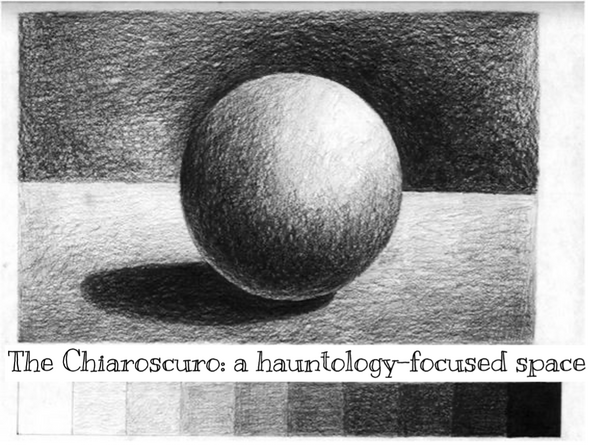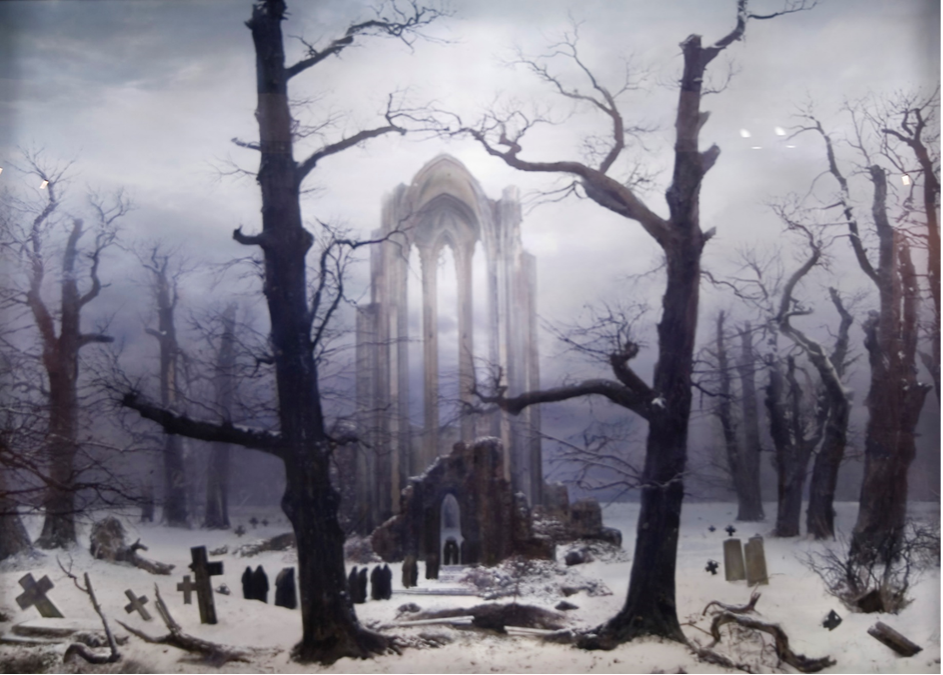A post by Emma Dee
Introduction
We begin, not with a text, but with an image.
This is a depiction of a painting by Caspar David Friedrich, a well-known German Romantic painter and explorer of the sublime. Not only is this a representation of what many of us might think of when we hear the term ‘Gothic,’ but the story of this particular image might help elucidate a concept of hauntology that this article is exploring. This picture is not the original.
In 2009, the artist Hiroyuki Masuyama created a series of five light boxes entitled ‘The Lost Works of Caspar David Friedrich,’ so named because none of the originals exist. Masuyama, working from photographs of the vanished and destroyed paintings, created a composite image of the original. The image is essentially haunted by the lost works, created by a series of digital memories and yet not of them. This summates a concept I have been exploring through my novel-in-progress as part of my Creative Writing PhD, namely, that of hauntology and how it relates to the embodied experience of trauma. The Gothic relates to extremes of experience; in this I’ll be looking specifically at gender-based sexual violence, the threat of which manifestly preoccupies the Gothic canon, and in the contemporary Gothic novel, how the text can be used to mirror the experience of sexual assault.
This article will examine depictions of ‘madness’ in the Gothic, particularly bipolar disorder, and how a more compassionate, understanding, and informed view of the same is needed. The Gothic has long been a space for exploring extremes of experience, to the point of ‘madness,’ a journey that could be described as a trauma narrative. This is where I feel the contemporary Gothic is able to forge a space beyond the ‘frightening’ sensationalism of the traditional Gothic canon into a radical revisioning.
Just as Masuyama worked with many digital ghosts, just as a painter works with numerous sketches, I will work with the seemingly disparate strands of hauntology, trauma narrative, illness narrative, and the Gothic canon in attempt to reconcile these into a revisioning of one of the Gothic’s most enduring, and problematic features, namely: “The Mad Woman in the Attic” (Gubar and Gilbert).
Hauntology and Lost Futures
In Merlin Coverley’s comprehensive and expansive text Hauntology: Ghosts of Futures Past, the term ‘hauntology’ is traced from Derrida and his work on Marx’s famous socialist spectre, to Mark Fisher and his work in the 1990s and early 2000s musical culture in ‘k-punk’ magazine. Coverley defines this as “the ghostly coming to invade every aspect of our lives, from the political and the technological to the cultural and the literary: to be is to be haunted” (Coverley 8). These ghostly invasions, not only of the past in the literal figure of the revenant, also represent an impossible future. Or, in the words of Fisher’s blog, “what he described as a ‘failure of the future’” (9). Coverley and Fisher are examining these on the scale of the public body, but what of the body personal?
Coverley notes that “[t]he past, as [Derrida] had suggested, refused to remain quarantined from the present and instead returned in unsettling and disruptive ways” (19). This not only is literally depicted in the Gothic, but it reminds me of the concept of trauma, and the embodied experience of it. If we accept Derrida’s assertion that to be is to be haunted, that every story is a ghost story, and every individual a sum of their past, this begins to link the concept of hauntology with the lived experience of trauma. Certainly, the phrases used when referring to a negative or unpleasant experience is that we are ‘haunted’ by it, that the experience will ‘come back to haunt us,’ turn us into ghosts, as a pale shadow of experience, mirrored in the very language we use.
Hauntology and the Classic Gothic Canon
If we consider hauntological thought in the classic Gothic canon, it is easy to see points of connection. Evil deeds return in echoing heartbeats under floorboards (Poe). Characters are trapped in haunted houses: “if those walls could speak, they could tell strange things, for they have looked upon sad doings” (Varma 19), wherein they are condemned to enact familial curses distilled from unspeakable desires, from The Castle of Otranto (Walpole)to The Monk (Lewis). Like the image at the beginning of this article, the Gothic contains echoes not only of the action within the novels themselves, but also from society, returning a distorted but engaged image. The Gothic becomes a hauntological metaphor for collective anxieties—repressed and dangerous sexualities from lesbianism in Carmilla (LeFanu) to incest in Wuthering Heights (Emily Brontë), grief, and the taboo.
It is for this very reason that members of the LGBTQ+ community (Hughes and Smith), people of colour (Taylor), women (Anderson), and other marginalised folk are drawn to the Gothic, for its depictions of alternative realities and ways of being. In depicting existence that goes against the norm, there is clear space for a neurodivergent experience within the Gothic. However, as seen in the above examples of the classic Gothic canon, these depictions often end in destruction. The Classic Gothic canon is haunted by these depictions, not only in the trauma of annihilation, but the potential future; an engagement with these experiences resulting in depictions that can elucidate, illuminate, and interpret lived experience.
Because it is not only the event—the trauma—as depicted in the Gothic returned literally by the figure of the revenant, but the potential future that has been lost, the ‘ghost of futures past’ as Coverley subtitles it. It is, of course, important to note that the experiences of marginalised people are not inherently traumatic; however, we can agree that society enacts trauma on those who do not ‘fit’ into the post-Enlightenment ideal of the straight, white, able-bodied, neurotypical man. As Hepzibah Anderson notes, “[i]n stories by women, when something goes bump in the night, it’s often the sound of the author butting her head against society’s rigid definitions of her role.” (Anderson n.p.). Similarly, many experiences of marginalised people can be objectively traumatic. And when trauma occurs, how is it dealt with? If we are thinking specifically of neurodivergent experiences, particularly issues with deteriorating mental health, some experiences can be traumatic—psychosis, anxiety, depression, delusions, hallucinations, to name but a few. All of which are elements of the Gothic, and in particular, that of “the mad woman in the attic” (Gilbert & Gubar).
As such, the contemporary Gothic is haunted by its legacy, but also by its duty to depict the experiences of marginalised—in this case, neurodivergent—people with more responsibility, to not enact further trauma on the stories of those who are neurodivergent, stories that the Gothic has been feeding vampire-like off for years. The narrative of ‘the mad woman’ and the narrative of ‘madness’ have often been observed adjacently, by the (often young, virginal, female) characters in the story, such as in Charlotte Brontë’s masterpiece Jane Eyre. It is worth noting that in Jean Rhys’ intertextual response, Wide Sargasso Sea, Antoinette ‘Bertha’ Rochester is given a voice, but only up until what we would perhaps now call her episode of psychosis. The ‘mad’ woman remains voiceless. As Susan Sontag notes in Illness as Metaphor:
Everyone who is born holds dual citizenship, in the kingdom of the well and in the kingdom of the sick. Although we all prefer to use only the good passport, sooner or later each of us is obliged, at least for a spell, to identify ourselves as citizens of that other place. (Sontag 3)
This surely relates not only to physical illness (Sontag is referring specifically to cancer and AIDS), but also mental health and all that this entails. The statistics are stark; mind.org states that one in four will experience a mental health problem of some kind each year in England. As Sontag goes on to elucidate, we have a duty towards a depiction that is not metaphorical and thus voiceless, based on pure ‘sensationalism.’ How then to reconcile this reality with the hauntological—indeed, metaphorical—language of the Gothic?
The Lived Experience of Trauma and Trauma Narratives
In his germinal work, The Body Keeps the Score, Besser Van Der Kolk explores the effects that trauma has on the brain and the body, noting that “[t]rauma [which] by definition is unbearable and intolerable.” (Kolk 1), and “while we all want to move beyond trauma […] it may be reactivated at the slightest hint of danger and mobilize disturbed brain circuits and secrete massive amounts of stress hormones” (2). Similarly, in the first section of the text (called “The Rediscovery of Trauma” in an interestingly hauntological turn of phrase), Kolk uses literary hauntological language in a quote from Jessica Stern, “That’s what trauma does. It interrupts the plot… it just happens, and then life goes on. No one prepares you for it” (7).
In my own novel, I explore this idea of trauma appearing and disappearing, like a bright star that blazes through the orbit of our personal worlds and out again, sometimes leaving no physical damage, but the memory.
And how is it, how is it, that some things happen. The most terrible of things, and yet you survive them. You come through them unscathed. They don’t leave a mark. You’d think, when you read in the papers, or hear on the news, of these terrible things, you’d think; I would be changed by that. I would never live through it. My self would warp and twist like a tree struck by lightning, as random and terrible. And it happens. And you live. And it barely leaves a mark. You don’t think about it every day. It is just another thing. That happened. (Extract from my unpublished novel-in-progress A House Called Winter)
In this section, I deliberately use the second person. There is a sense of remove, of observation, which is mirrored in the nature of reading a novel itself wherein we see the world through someone else’s eyes. In this way, then, perhaps the text is holding up a hauntological mirror to the reader in direct address.
Gothic characters and survivors of trauma in these moments, are haunted by what happened, but also the potential of it not having happened. This is the moment where the lost future of the self occurs, in a schism, and past and future is forever delineated, as well as a third, potential future lost forever; the future where trauma did not occur. As Kolk notes, “[i]t’s hard enough to face the suffering that has been inflicted by others, but deep down many traumatized people are even more haunted by the shame they feel about what they themselves did or did not do” [emphasis mine] (13). The paradox is as it stands: how can there have been a future after this experience that was so awful? How can there be a future wherein the individual did not behave as they might believe they ought?
The Gothic often plays with an unreliable narrator and a sense of doubt. Trauma survivors can lack the ability or inclination to express what has happened. In my novel-in-progress, my main character, Jenny, is experiencing a manic episode brought on by the experience of trauma. How then to write this experience, to use linguistic tools, in a way that is responsible? In the same way that the body physically keeps the score, what about the body of the text, and the subversion of traditional technological markers? The hauntological Gothic, and trauma experiences and recurrences concertina time; hours seem like minutes, the past is present, the future frozen and unattainable. How to reflect this in the body of the text?
In the process of my research, I encountered many insightful and informative texts about illness narrative, particularly Tristimania by Jay Griffiths. Within it, I was struck by how this particular narrative of a bipolar episode had many contact points with the narrative arc of Gothic fiction, from an inciting incident or catalyst, through ‘the dark night of the soul’ and back again. Or, as Aristotle would plot; equilibrium, disequilibrium, equilibrium. Indeed, the cyclical nature of some types of neurodivergence mirror narrative arcs. This itself contains troubling potential issues; in imposing a structural arc upon a lived experience, does this create an expectation of a certain ‘kind’ of ending, and a certain ‘right’ way to have lived an experience?
Similarly, if a lived experience is to be depicted responsibly, how can the texture of the narrative reflect that? In terms of Derridean thought, words are ‘haunted’ by their adjacent meanings. They are defined in terms of negation. The experience of bipolar sometimes gives rise to ‘clang’ associations, where words disrupt meaning, associated by sound or texture rather than meaning. Similarly, compelling fiction follows the same rules as the reality of trauma—trauma is not remembered, it is relived, “reactivated” (Kolk 2)—and compelling fiction is embodied. Mary Kerr notes that “strangely, readers ‘believe’ what’s rendered with physical clarity.” (n.p), something that she refers to in her work as “sacred carnality,” and there is something sacred about the exploration of these extremes of experiences. The prose returns to embodied feeling. In the section where Jenny recounts her trauma, I have tried to hold these occasionally at-odds ideas in balance. The narrative is for those experiencing trauma, but also those who are not, but can access it through this idea of carnality, not only for curiosity or ‘sensationalism’ but understanding.
I have tried to be mindful of the way that language itself can also enact and maintain trauma; the history of any medicalised or pathologized experience—from womanhood, to neurodivergence, to gendered violence—is fraught with phraseology used to enact, justify, and perpetuate trauma. Through the lack of punctuation and the deliberate run-on sentences I am trying to depict the unrelenting (re)enactment of trauma, and through repetition the strange details that stick in one’s mind. The hauntological and Gothic image of the underground transport system, where Jenny’s trauma is first enacted, is one that I feel is deeply Gothic in a modern sense; reducing distance and time, as well as creating a simultaneous sense of movement and stasis as we move through the (re)memory, through past in present, into the relative calm of post-memory.
I am angry that I turned when a hand was on my arm and I am angry that he went to touch my face with violence and I am angry that I got my face away but I couldn’t save my hair and I am angry that he touched me with violence and his body on mine and the insides of his body that he had touched whilst looking at me touching me with his eyes and his ugly ugly mind like a worm and he in his hand he his hand he had in his hand and he got my hair and the doors shut with him inside and me outside on the floor
It is a thing.’ She feels her mouth say. ‘It is a thing, a ring, a sing, a wing that happens. Just a thing.’ (extract from A House Called Winter)
Futures Found
It is here that I feel the contemporary Gothic has a duty and a responsibility to the voiceless of its past, the mute Gothic ghosts. It has often been a trope that draws marginalised people to it with its depictions of alternative, subversive existence. Yet it often fails at the final hurdle. The Gothic has always been exploring these hauntological and trauma narrative tropes, indeed it is haunted by them, but unfortunately with the language and tools available at the time, sometimes purely for ‘sensation’. Georges Bataille states that literature is evil; against the good. I take this to mean, it goes into spaces of taboo and extremes of human experience to provide answers and clarity of experience. The contemporary Gothic, therefore, will become as the image at the beginning of this article; of its past, and yet embodying its impossible future, a future that is no longer lost. Within the novel, the reader enters into that sacred space, where the lost futures of the Gothic can be reconciled and exorcised with narrative experience. In fact, writing that doesn’t dare to do this is dull indeed.




No comments:
Post a Comment